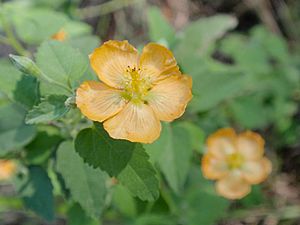Texas Indian mallow facts for kids
Quick facts for kids Texas Indian mallow |
|
|---|---|
 |
|
| Conservation status | |
| Scientific classification | |
| Genus: |
Abutilon
|
| Species: |
fruticosum
|
| Synonyms | |
|
List
Abutilon denticulatum (Fresen.) Webb
Abutilon dubium Mattei Abutilon fruticosum var. chrysocarpum Blatt. & Hallb. Abutilon fruticosum var. microphyllum (A.Rich.) Abedin Abutilon fruticosum var. saidae Abedin Abutilon microphyllum A.Rich. Abutilon nuttallii Torr. & A.Gray Abutilon texense Torr. & A.Gray Sida amoena Wall. Sida denticulata Fresen. Sida gracilis R.Br. Sida kotschyi Hochst. ex Mast. Sida perrottetiana D. Dietr. |
|
Abutilon fruticosum is a cool flowering plant. It belongs to the mallow family. People call it by many names, like Texas Indian mallow or sweet Indian mallow. This plant grows in many places around the world. You can find it in Africa, parts of Asia, northern Mexico, and the south-central United States.
Contents
What is Abutilon fruticosum?
This plant is a perennial herb. This means it lives for more than two years and has soft stems, not woody ones like a tree. It can grow up to 1.8 meters (6 feet) tall. But usually, it stays shorter, around 90 centimeters (3 feet).
Its leaves grow in an alternating pattern along the stem. Each leaf can be up to 10 centimeters (4 inches) long. The leaves feel thick and are covered in tiny hairs. This makes them look a bit gray.
Flowers and Blooming Time
The flowers of Abutilon fruticosum are a bright yellow-orange color. They are about 2.5 centimeters (1 inch) wide. If you are in Texas, you can see these flowers blooming from June through October.
Where Does This Plant Grow?
Abutilon fruticosum is quite tough and can grow in different places. You might find it in chaparral areas, which are like shrublands. It also grows in woodlands and on open prairies. This plant likes rocky spots too. It often grows on cliffs, slopes, and places with limestone rocks.
How Does This Plant Help Nature?
This plant is important for many animals. Wild animals and farm animals like ungulates (animals with hooves, like deer or cows) eat it. Its seeds are a tasty food source for birds. For example, the bobwhite quail loves to eat the seeds.
Attracting Wildlife
The bright flowers of Abutilon fruticosum attract many creatures. Birds and butterflies often visit the plant. It's also a special home for some butterfly larvae (caterpillars). They feed on the plant as they grow.
Uses for People
Abutilon fruticosum is a very strong plant. It can handle dry weather and doesn't need much water. Because of this, it's a great choice for xeriscaping. This is a type of landscaping that uses plants that need very little water. It helps save water, especially in dry areas.


